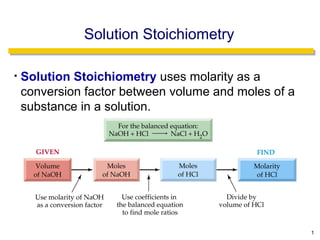Denunciar
Compartir

Recomendados
Recomendados
Más contenido relacionado
La actualidad más candente
La actualidad más candente (20)
Destacado
Destacado (20)
Similar a Titrations
Similar a Titrations (20)
NCHE 211 UNIT 2 VOLUMETRY and Complexometry titration.pdf

NCHE 211 UNIT 2 VOLUMETRY and Complexometry titration.pdf
Preparing, Diluting of solutions of different Strengths & safety measures whi...

Preparing, Diluting of solutions of different Strengths & safety measures whi...
Titration methods for quantification of pharmaceutical products

Titration methods for quantification of pharmaceutical products
Scanned with CamScanner1 STANDARIZATION OF A B.docx

Scanned with CamScanner1 STANDARIZATION OF A B.docx
Más de James Midgley
Más de James Midgley (18)
Titrations
- 1. Solution Stoichiometry • Solution Stoichiometry uses molarity as a conversion factor between volume and moles of a substance in a solution. 1
- 2. Solution Stoichiometry • Titration: • A technique for determining the concentration of a solution. 2
- 3. Titrations Titration: the process of analyzing composition by measuring the volume of one solution needed to completely react with another solution. This is a special case of a Limiting Reagent! Usually the reaction of an acid with a base. 3
- 4. Titrations Analyte: the solution of unknown concentration but known volume. Titrant: the solution of known concentration. Analyte + Titrant → Products Add titrant until all of the analyte has reacted, then detect the excess of titrant. 4
- 5. Titrations Equivalence Point: the point at which exactly the right volume of titrant has been added to complete the reaction. Indicator: substance that changes color when an excess of titrant has been added (phenolphthalein, bromocresol green). 5
- 6. Titrations Titration Calculations: 1. Find the number of moles of titrant added to reach the endpoint. 2. Determine the moles of analyte that must have been present (use stoichiometric coefficients). 3. Determine the concentration of analyte that must have been present in the flask (use the volume of analyte). 4. Calculate the concentration of analyte in the original sample. 6
- 7. Titrations Example #1: 14.84 mL of an HCl solution of unknown concentration is titrated with standard NaOH solution. At the equivalence point, 25.0 mL of the 0.675 M NaOH has been added. Calculate the concentration of the HCl solution. NaOH + HCl → NaCl + H2O Titrant = ? Analyte = ? (1.14 M) 7
- 8. Titrations Example #2: An antacid tablet containing sodium bicarbonate (NaHCO3) and weighing 4.00 g is dissolved in water. The solution is titrated to the equivalence point with 50.0 mL of 0.200 M HCl. Calculate the mass% of sodium bicarbonate in the tablet. NaHCO3 + HCl → NaCl + H2O + CO2 Titrant = ? Analyte = ? (21.0%) 8